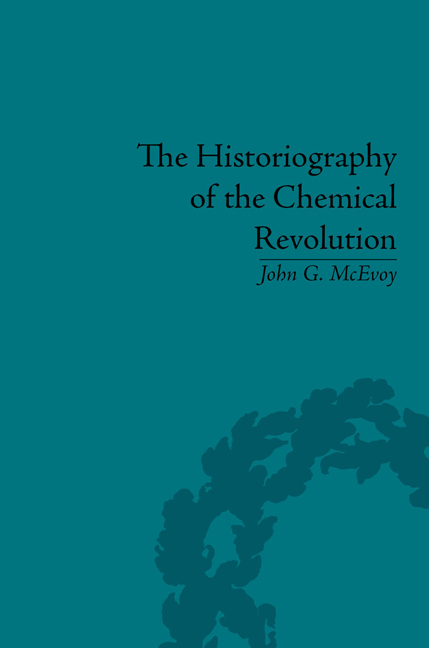Refine search
Actions for selected content:
10306 results in History of science: general interest
7 - Personifying Electricity: Gendered Icons of Uncertain Identity
-
- Book:
- Domesticating Electricity
- Published by:
- Pickering & Chatto
- Published online:
- 05 December 2014, pp 197-218
-
- Chapter
- Export citation

The Historiography of the Chemical Revolution
- Patterns of Interpretation in the History of Science
-
- Published by:
- Pickering & Chatto
- Published online:
- 05 December 2014
-
- Book
- Export citation
2 - An Active Nature: Robert Hunt and the Genres of Science Writing
- from I - Literary Genres of Science Writing
-
-
- Book:
- Uncommon Contexts
- Published by:
- Pickering & Chatto
- Published online:
- 05 December 2014, pp 39-54
-
- Chapter
- Export citation
CONTENTS
-
- Book:
- Communicating Physics
- Published by:
- Pickering & Chatto
- Published online:
- 05 December 2014, pp vii-vii
-
- Chapter
- Export citation
Works Cited
-
- Book:
- The British Arboretum
- Published by:
- Pickering & Chatto
- Published online:
- 05 December 2014, pp 265-292
-
- Chapter
- Export citation
Acknowledgments
-
- Book:
- Styles of Reasoning in the British Life Sciences
- Published by:
- Pickering & Chatto
- Published online:
- 05 December 2014, pp vii-viii
-
- Chapter
- Export citation
6 - Scientific Motives and Civic Virtue
-
- Book:
- Natural History Societies and Civic Culture in Victorian Scotland
- Published by:
- Pickering & Chatto
- Published online:
- 05 December 2014, pp 147-170
-
- Chapter
- Export citation
Frontmatter
-
- Book:
- Vision, Science and Literature, 1870–1920
- Published by:
- Pickering & Chatto
- Published online:
- 05 December 2014, pp i-vi
-
- Chapter
- Export citation
Notes
-
- Book:
- Recreating Newton
- Published by:
- Pickering & Chatto
- Published online:
- 05 December 2014, pp 195-246
-
- Chapter
- Export citation
1 - Voluntary societies
-
- Book:
- Communities of Science in Nineteenth-Century Ireland
- Published by:
- Pickering & Chatto
- Published online:
- 05 December 2014, pp 11-42
-
- Chapter
- Export citation
Dedication
-
- Book:
- Communicating Physics
- Published by:
- Pickering & Chatto
- Published online:
- 05 December 2014, pp viii-viii
-
- Chapter
- Export citation
List of Illustrations and Tables
-
- Book:
- Recreating Newton
- Published by:
- Pickering & Chatto
- Published online:
- 05 December 2014, pp ix-x
-
- Chapter
- Export citation
Dedication
-
- Book:
- Recreating Newton
- Published by:
- Pickering & Chatto
- Published online:
- 05 December 2014, pp viii-viii
-
- Chapter
- Export citation
Works Cited
-
- Book:
- Styles of Reasoning in the British Life Sciences
- Published by:
- Pickering & Chatto
- Published online:
- 05 December 2014, pp 205-226
-
- Chapter
- Export citation
4 - Erasmus Darwin's Vision of the Future: Phytologia
-
- Book:
- The Aliveness of Plants
- Published by:
- Pickering & Chatto
- Published online:
- 05 December 2014, pp 31-54
-
- Chapter
- Export citation
Introduction
-
- Book:
- Astronomy in India, 1784–1876
- Published by:
- Pickering & Chatto
- Published online:
- 05 December 2014, pp 1-12
-
- Chapter
- Export citation
Works Cited
-
- Book:
- Natural History Societies and Civic Culture in Victorian Scotland
- Published by:
- Pickering & Chatto
- Published online:
- 05 December 2014, pp 223-246
-
- Chapter
- Export citation
Frontmatter
-
- Book:
- The Aliveness of Plants
- Published by:
- Pickering & Chatto
- Published online:
- 05 December 2014, pp i-iv
-
- Chapter
- Export citation
Index
-
- Book:
- Domesticating Electricity
- Published by:
- Pickering & Chatto
- Published online:
- 05 December 2014, pp 287-292
-
- Chapter
- Export citation
Acknowledgements
-
- Book:
- Popular Exhibitions, Science and Showmanship, 1840–1910
- Published by:
- Pickering & Chatto
- Published online:
- 05 December 2014, pp ix-x
-
- Chapter
- Export citation
